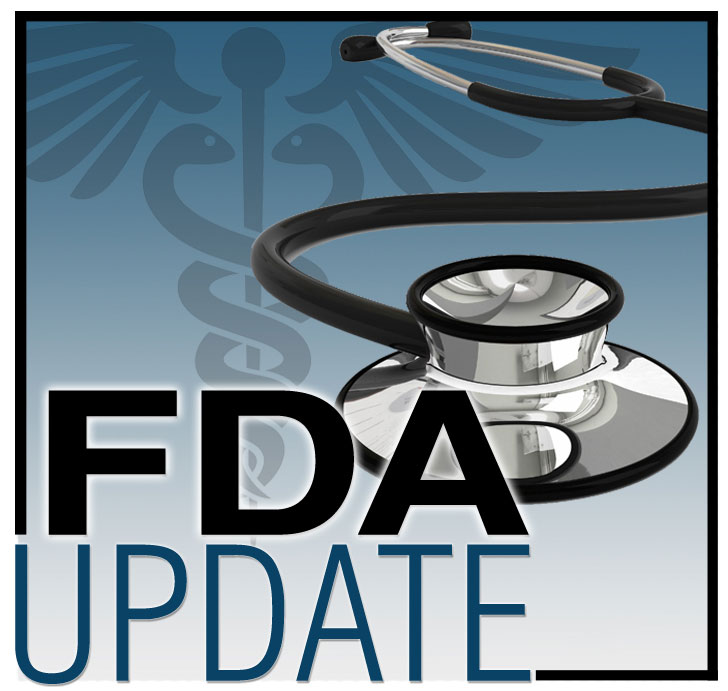
On January 26, 2018, the U.S. Food and Drug Administration (FDA) approved lutetium Lu 177 dotatate (Lutathera®) a radiolabeled somatostatin analog, for the treatment of somatostatin receptor-positive gastroenteropancreatic neuroendocrine tumors (GEP-NETs), including foregut, midgut, and hindgut neuroendocrine tumors in adults.
Approval was based on data from NETTER-1 (NCT01578239), a randomized, multicenter, open-label, active-controlled trial in 229 patients with progressive, well-differentiated, locally advanced/inoperable or metastatic somatostatin receptor-positive midgut carcinoid tumors. Patients were randomized (1:1) to receive either lutetium Lu 177 dotatate (7.4 GBq [200 mCi] every eight weeks for up to four administrations; maximum cumulative dose of 29.6 GBq) with long-acting octreotide (30 mg by intramuscular injection every four weeks) or high-dose long-acting octreotide (60 mg by intramuscular injection every four weeks). Lutetium Lu 177 dotatate was co-administered with an amino acid solution as a renal protectant. In the United States, patients enrolled in NETTER-1 received a commercially available solution of amino acids.
The major efficacy outcome measure was progression‑free survival (PFS) determined by a blinded independent radiology committee using RECIST 1.1. The median PFS was not reached for lutetium Lu 177 dotatate and was 8.5 months in the high-dose long-acting octreotide arm (hazard ratio = 0.21; 95% CI = 0.13, 0.32; p < 0.0001).
The efficacy of lutetium Lu 177 dotatate was also assessed in a subset (n = 360) of 1,214 patients enrolled in the ERASMUS Medical Center (MC) study with GEP-NET tumors who were assessed according to RECIST criteria. At the ERASMUS MC, lutetium Lu 177 dotatate was initially provided as expanded access under a general peptide receptor radionuclide therapy protocol at a single site in the Netherlands. Lutetium Lu 177 dotatate (7.4 GBq [200 mCi]) was administered every 6–13 weeks for up to four doses. The ORR was 16% (n = 58), including three complete responses in this subset of 360 patients with GEP-NETs who were assessed according to RECIST criteria.
In the NETTER-1 study, the most common grade 3–4 adverse reactions occurring with a greater frequency (at least 4%) among patients receiving lutetium Lu 177 dotatate with long-acting octreotide compared to patients receiving high-dose octreotide alone included lymphopenia (44%), increased GGT (20%), vomiting (7%), nausea and elevated AST (5% each), and increased ALT, hyperglycemia, and hypokalemia (4% each). In NETTER-1, with a median follow-up of 24 months, myelodysplastic syndrome was reported in 2.7% of patients receiving lutetium Lu 177 dotatate with long-acting octreotide; no patients receiving high-dose octreotide LAR developed myelodysplastic syndrome.
The recommended dose of lutetium Lu 177 dotatate is 7.4 GBq (200 mCi) as an intravenous infusion over 30 minutes every eight weeks for a total of four doses.
Full prescribing information is available.
FDA granted priority review for this application and previously granted orphan drug designation to lutetium Lu 177 dotatate for treatment of GEP-NETs. A description of FDA expedited programs is in the Guidance for Industry: Expedited Programs for Serious Conditions-Drugs and Biologics.
Healthcare professionals should report all serious adverse events suspected to be associated with the use of any medicine and device to FDA’s MedWatch Reporting System by completing a form online, by faxing (800-FDA-0178) or mailing the postage-paid address form provided online, or by telephone (800-FDA-1088).
In collaboration with the FDA and as a service to our members, ONS provides updates on recent FDA approvals and other important FDA actions (e.g., updated safety information, new prescribing information) pertaining to therapies for patients with cancer. This allows the agency to inform oncologists and professionals in oncology-related fields in a timely manner. Included in the FDA updates is a link to the product label or to other sites for additional relevant clinical information. In supplying this information, ONS does not endorse any product or therapy and does not take any position on the safety or efficacy of the product or therapy described.





